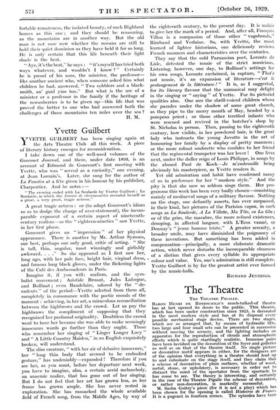The Theatre
THE THEATRE PIGALLE.
BARON HENRI DE ROTHSCHILD'S much-talked-of theatre has at last opened its doors to the public. This theatre, which has been under construction since 1925, is decorated in the most modem style and has at its disposal every possible mechanical stage device. There are two stages, which are so arranged that, by means of hydraulic lifts, two large and four small sets can be presented in succession without moving the scenery, and the lighting includes an apparatus for the reproduction of clouds and atmospheric effects which is quite startlingly realistic. Immense pains have been lavished on the decoration of the foyer and galleries as well as on that of the theatre itself. No single picture or decorative motif appears in either, for the designers are of the opinion that everything in a theatre should lead up to and culminate on the stage itself, and they claim that a scheme of decoration of plain surfaces, whether of wood, metal, stone, or upholstery, is necessary in order not to distract the mind of the spectator from the spectacle he has come to see. The theory is interesting, and certainly in the case of the Theatre Pigalle the scheme of decoration, or rather non-decoration, is markedly successful. M. Sacha Guitry's piece (for it is not a play) which has been chosen for the opening is called Histoires de France. It is a pageant in fourteen scenes. The episodes have been chosen without any very obvious relation to each other, find each stands or falls on its own merits, which undoubtedly imposes a certain strain on the spectator. We are taken from pre-Roman Gaul, by way of Joan of Arc, with a glimpse Of the dying Louis XI, to watch Francois Premier and his court in the gardens of Fontainebleau, all in the first act. But although by the end we have arrived at the garden of the painter Monet in 1918, M. Guitry manages the journey o well that we never become tired of it.
M. Busser's orchestra plays either his own charming music or the airs of the period, Mademoiselle Yvonne Printemps sings ,• and Henry of Navarre, Richelieu, Louis XIV, Napoleon I, Napoleon III, Monsieur Thiers, and finally Clemenceau himself all appear in turn, and we are delighted to see them. The decors are sometimes excellent, notably that of Versailles in the time of Louis XIV, and the costumes perhaps the most striking thing of the whole entertainment. It is one which is admirably adapted to show off the scenic resources of the new theatre, but which, by its very lack of a central theme, demands a very light touch and the utmost Support from every incidental accessory such as music, lighting, and mire en seine. All these are of the very best, and M. Sacha Guitry does not disappoint his many admirers. Tt is all a little inconsecutive, and one is sometimes tempted to wonder why it was ever done except to make a charming spectacle ; but within the limits of such an entertainment
M. Guitry has succeeded admirably. J. S.



















































 Previous page
Previous page